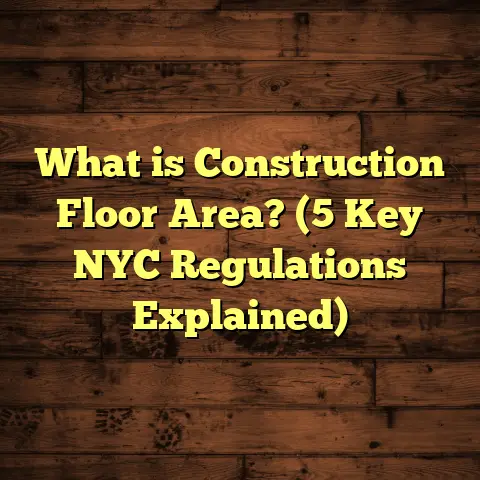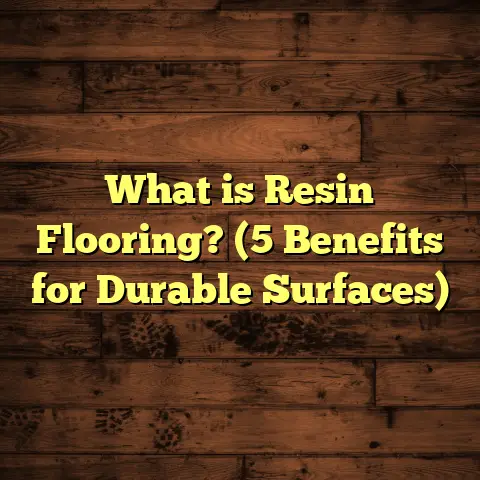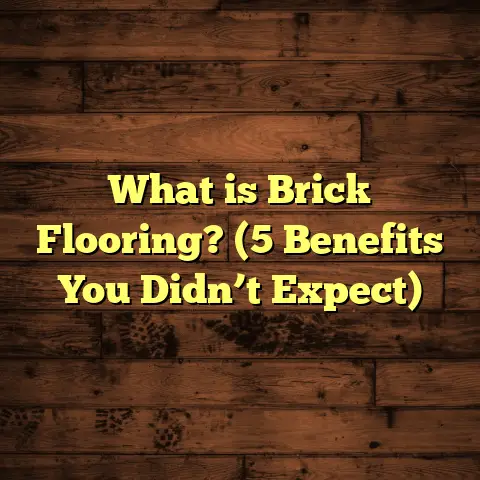What is Cheaper: Tile or Wood Floors? (5 Cost Factors Explained)
Shocking fact: Did you know that many homeowners spend thousands on flooring only to regret their choice within a few years because they didn’t fully understand the costs involved? I’ve seen it happen more times than I can count. Flooring isn’t just about picking something that looks good; it’s about understanding the long-term financial commitment and maintenance involved. Choosing between tile and wood floors is one of the most common dilemmas—and the cost question is always right at the center.
What is Cheaper: Tile or Wood Floors?
When you ask, “What is cheaper: tile or wood floors?”, you’re really diving into an entire spectrum of costs over the lifespan of your floor. It’s not just about the initial price tag of the material but also factors like installation, upkeep, durability, and even how the floor impacts your home’s resale value.
Tile floors typically mean ceramic, porcelain, or natural stone options. Wood floors include solid hardwood and engineered wood varieties. Both have their own sets of pros and cons—and price tags that can vary widely.
Let me walk you through five key cost factors that will help you decide which flooring type might be better for your budget—and your lifestyle.
1. Material Cost – The Starting Point
Most people start by comparing material prices. Here’s what I’ve learned from working with hundreds of clients:
- Tile: Material prices range widely. Basic ceramic tile can be as low as $1 per square foot, while high-end natural stones like marble or travertine can cost $15 to $20+ per square foot. Porcelain tiles tend to be in the $3 to $7 per square foot range and offer a nice balance between price and durability.
- Wood: You’ve got solid hardwood and engineered wood to consider. Solid hardwood usually starts around $5 per square foot but can climb above $15 for exotic species like Brazilian cherry or walnut. Engineered wood is generally less expensive—ranging from $3 to $10 per square foot depending on quality and thickness.
You might think tile is cheaper overall because of those low-cost ceramic options. But cheaper tile often means lower durability or less appealing aesthetics.
Why Material Cost Alone Isn’t Enough
Here’s something I’ve learned firsthand: focusing only on material price is like buying a car without thinking about fuel or maintenance costs. For example, I once had a client who chose a cheap ceramic tile at $1.50/sq ft thinking they were saving money. Six months later, several tiles cracked because the subfloor wasn’t properly prepared—turns out the low-quality tile couldn’t handle slight movement.
On the flip side, I’ve worked with homeowners who splurged on exotic hardwood species but ignored installation costs and maintenance needs. They ended up spending more than planned in repairs and refinishing.
2. Installation Costs – What Are You Really Paying For?
Installation can be surprisingly pricey, especially with tile. Laying tile involves:
- Preparing the subfloor properly (leveling, moisture barriers)
- Cutting tiles precisely to fit edges and corners
- Applying mortar and grout carefully
- Sealing grout lines to prevent stains
Because tile installation requires skill and time, labor charges usually run between $4 and $12 per square foot depending on tile size, pattern complexity, and location.
Wood floor installation tends to be quicker and less labor-intensive. Engineered wood often comes with click-lock systems that snap together over underlayment—great for DIYers or fast installs. Solid hardwood requires nailing or gluing but generally costs less than tile installation, typically $3 to $8 per square foot.
Installation Complexity Can Make or Break Your Budget
I remember a job where a homeowner wanted a detailed mosaic tile pattern in their kitchen backsplash area. The tile cost was reasonable, but because of all the tiny cuts and pattern alignment, the labor bill ended up being three times the material price! That’s when I told them sometimes simpler tile patterns can save serious money.
Conversely, I installed engineered wood flooring in a rental property for a client who wanted quick turnover. The installation took just two days for 1,000 sq ft, costing less than half what tile would have been.
3. Maintenance Costs – Keeping Floors Looking Good
Tile floors are known for being durable and easy to clean, but grout lines need some attention. Grout can stain or crack over time if not sealed properly. Professional grout sealing every 1-2 years usually costs about $0.50 per square foot.
Wood floors need more regular care:
- Sweeping/dusting regularly to avoid scratches
- Using wood-safe cleaners
- Refinishing every 7-10 years to restore shine and fix surface damage
Refinishing wood floors can cost between $2 and $5 per square foot depending on wear and finish type.
Moisture Sensitivity: A Hidden Cost for Wood Floors
Wood doesn’t like water—it can warp, cup, or swell in humid environments or if spills aren’t cleaned quickly. Repairing water damage on wood floors can run into hundreds or thousands of dollars depending on severity.
Tile is much more resistant to moisture but can crack if something heavy is dropped on it or if the subfloor shifts.
From My Experience:
I worked with a family living in a coastal home where humidity levels were high year-round. They chose solid hardwood flooring but skipped installing a proper vapor barrier underneath. Within two years, they noticed cupping and warping in several rooms, forcing expensive replacement of planks and refinishing elsewhere.
If they had chosen tile, this problem might have been avoided altogether.
4. Lifespan and Durability – How Long Will Your Floor Last?
When thinking about cost, lifespan matters big time. A floor that lasts 30 years at a higher upfront cost may be cheaper long term than one that needs replacement after 10 years.
- Tile: High-quality tiles can last 30+ years with proper care. Porcelain especially is known for its hardness and scratch resistance.
- Wood: Solid hardwood floors typically last 20-30 years or more with refinishing every decade or so. Engineered wood has a thinner top veneer layer limiting how many times it can be sanded down—usually 1-3 times max.
Tile is brittle though—if it cracks, replacing single tiles can be tricky without matching new ones perfectly.
Satisfaction Over Time
A HomeAdvisor survey showed that homeowners maintaining hardwood floors properly reported satisfaction rates above 85% after 25 years; tile owners reported around 90% satisfaction but noted grout upkeep as a downside.
I’ve seen both materials age well in different homes, but the key is regular maintenance and choosing quality products.
5. Aesthetic Appeal & Resale Value – What Will Buyers Pay For?
Flooring is one of the first things potential buyers notice when touring a home. Wood floors often create warmer feelings and are associated with luxury, which is why they usually add more perceived value.
According to the National Wood Flooring Association (NWFA), homes with hardwood floors sell faster and at higher prices compared to those with other flooring types.
Tile’s impact depends heavily on style and quality:
- High-end natural stone tiles can boost home value significantly.
- Basic ceramic tiles rarely influence resale much unless in kitchens/baths.
- Large-format modern tiles are trendy but not universally loved by buyers yet.
A Personal Take:
I had a client debating between large-format porcelain tiles versus classic oak floors for their living room remodel. They went with wood because of its timeless appeal and ended up selling their home for 10% more than expected partly due to that choice.
Bonus Factor: Waste & Extra Material Costs
Don’t forget waste factors—cutting tiles or wood planks generates scrap that you need to account for when buying materials.
Tile typically requires ordering 10-15% extra to cover breakage and cuts; wood might need around 5-10% extra depending on room complexity.
Using tools like FloorTally helps estimate these numbers precisely based on your project specifics so you don’t overspend or run short mid-installation.
Personal Stories & Lessons Learned
Over the years as a flooring contractor, I’ve gathered lots of insights beyond just numbers:
- One client saved thousands by selecting engineered wood over solid hardwood—not just due to material price but also faster installation time.
- Another homeowner regretted choosing cheap ceramic tile after multiple cracked pieces forced early replacement.
- In humid climates, I always recommend tile or engineered wood with proper moisture barriers instead of solid hardwood.
- I’ve seen clients underestimate labor costs for complicated tile layouts by hundreds or thousands of dollars.
- Maintaining grout properly makes all the difference in how long tile keeps looking new.
- Refinishing hardwood every decade keeps floors looking fresh but adds recurring costs many forget about.
All these experiences taught me that there’s no one-size-fits-all answer. It really depends on your home environment, lifestyle, budget flexibility, and taste.
Let’s Talk Numbers: Case Study Examples
Here’s a practical breakdown for a typical 1,000 sq ft floor:
| Flooring Type | Material Cost (avg) | Installation Cost (avg) | Maintenance (annual est.) | Lifespan (yrs) | Total Cost Over 20 Years |
|---|---|---|---|---|---|
| Ceramic Tile | $3,000 | $6,000 | $150 (grout sealing) | 30+ | ~$6,000 + ongoing maintenance |
| Porcelain Tile | $5,000 | $7,000 | $150 | 30+ | ~$7,000 + ongoing maintenance |
| Solid Hardwood | $7,000 | $5,000 | $300 (refinishing) | 25-30 | ~$12,000 + refinishing costs |
| Engineered Wood | $4,000 | $4,000 | $200 | 15-20 | ~$8,000 + possible partial refinish |
These numbers vary widely by region but give you an idea of relative costs. Tile’s upfront installation cost is generally higher due to labor intensity; wood’s finishing requirements add recurring expenses.
What About Environmental Impact & Sustainability?
If you care about sustainability:
- Wood flooring can be eco-friendly if sourced responsibly (look for FSC certification).
- Engineered wood uses less hardwood per plank so it’s sometimes better for forests.
- Tile manufacturing involves energy-intensive firing processes but lasts long.
- Both materials have recyclable components depending on disposal options.
This isn’t directly cost-related but increasingly influences homeowner choices—and resale appeal too.
Final Thoughts: Which One Should You Choose?
I often tell clients: think about your lifestyle first.
- If you want something tough that handles moisture well (kitchens, bathrooms), tile might be better.
- If you crave warmth and natural beauty plus higher resale value, wood could be worth the extra upfront spend.
Also consider maintenance willingness—tile grout upkeep versus periodic wood refinishing.
If budget is tight upfront but you want longevity with low hassle, mid-range porcelain tile tends to hit that sweet spot.
For cozy living areas where comfort matters more than splash resistance, engineered or solid hardwood floors shine.
How You Can Use Tools Like FloorTally
To avoid surprises when budgeting your project, I recommend online tools like FloorTally. It helps you:
- Get precise material + labor estimates based on your zip code
- Experiment with different materials & see instant cost changes
- Add waste factors so you buy right amount of product
- Visualize total project cost clearly before signing contracts
I’ve used FloorTally myself when advising clients—it saves tons of back-and-forth phone calls and guesswork.
FAQs You Might Be Wondering About
Q: Can I install tile or wood myself to save money?
A: If you have good DIY skills and patience, engineered wood click-lock systems are easier for beginners. Tile installation is tricky—cutting tiles and grouting takes experience to get right without costly mistakes.
Q: What about radiant heating compatibility?
A: Both tile and engineered wood work well over radiant heat systems; solid hardwood can be tricky due to expansion/contraction issues.
Q: How do I keep grout clean long-term?
A: Regular sealing plus using mild cleaners helps prevent stains. Avoid acidic cleaners which degrade grout over time.
Q: Is vinyl flooring a cheaper alternative?
A: Yes, vinyl can be significantly cheaper upfront but lacks the luxury feel of real tile or wood and generally doesn’t add resale value.
Thanks for sticking around through this detailed look! Flooring is one of those investments where knowing all the facts upfront really pays off later. If you want me to help crunch numbers for your specific project or suggest styles within your budget, just ask!





